

Internal Alignment and Employee Engagement Are Not the Same. By Rick DeMarco, Managing Director, West Coast, Inward Strategic Consulting I have spent many hours talking to both CMOs and SVPs of Human Resources around the country, and one theme constantly emerges regarding the biggest challenges facing them in the activation of their business strategy and delivery of their brand promise.
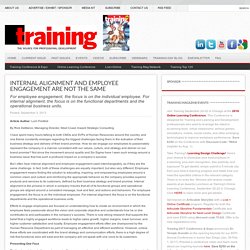
How do we engage our employees to passionately represent the company in a manner consistent with our values, culture, and strategy and deliver on our brand promise? Not since the movement around quality and Six Sigma have I seen such energy around a business issue that has such a profound impact on a company’s success. Interne communicatie - Zo houd je de perfecte town hall meeting. Communicatie | 3 februari 2016, 11:28 Infographic met tips en adviezen De mouwen opgestroopt, jasje uit en in gesprek gaan met een groep kiezers, werknemers of bewoners.

De town hall meetings worden al een tijdje ingezet in de communicatie met doelgroepen, ook voor interne doeleinden. Maar hoe zorg je ervoor dat het een levende bijeenkomst is, zoals die ook is bedoeld? Hoe voorkom je dat het een losstaand evenementje is? Het Amerikaanse communicatiebureau Alive With Ideas heeft een infographic gemaakt voor het houden van town hall meetings. Een tip geven we al weg: heb plezier! (klik hier voor een grotere versie) Artikel de essentie van interne communicatie. How to craft an effective year-end staff message. Tone, timing and delivery method are essential considerations when you're expressing gratitude, lauding the year's achievements, and offering your vision for the coming year.

By Linda Beheler | Posted: December 11, 2014 If you manage a team or company, it's time to develop your end-of-year message to employees. The reflective nature of the holiday season and the symbolism of the new year provide the opportunity to highlight significant achievements and focus on the priorities ahead. Timothy_Hughes: The definition of Purpose #quote ... Communicating effectively through a merger or acquisition. 7 key steps you can take to optimise internal communication when your company is acquiring another, or is being acquired or merged By Marc Wright Mergers and acquisitions are two of the most important drivers in increasing the need for internal communication in both buying and target companies.
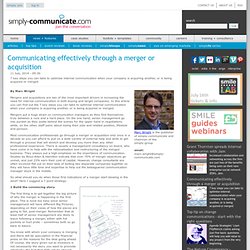
In this article you can find out the 7 key steps you can take to optimise internal communication when your company is acquiring another, or is being acquired or merged. Mergers put a huge strain on communication managers as they find themselves truly between a rock and a hard place. On the one hand, senior management go into purdah as they jostle behind the scenes for the upper hand in negotiations while, on the other, staff panic about losing their jobs and related position, lifestyle and pension. So what should you do when those first indications of a merger start blowing in the wind? 1 Build the convincing story 2. Four Types of Employee Engagement.
By Melissa J.
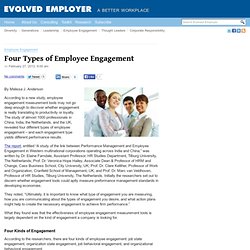
Anderson According to a new study, employee engagement measurement tools may not go deep enough to discover whether engagement is really translating to productivity or loyalty. The study of almost 1000 professionals in China, India, the Netherlands, and the UK, revealed four different types of employee engagement – and each engagement type yields different performance results. The report, entitled “A study of the link between Performance Management and Employee Engagement in Western multinational corporations operating across India and China,” was written by Dr. Elaine Farndale, Assistant Professor, HR Studies Department, Tilburg University, The Netherlands; Prof. Verschil Engagem & Mngt. A stakeholders matrix showing which strategies to use.
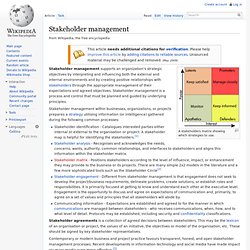
Stakeholder management within businesses, organizations, or projects prepares a strategy utilising information (or intelligence) gathered during the following common processes: Stakeholder identification - Catalogues interested parties either internal or external to the organisation or project. A stakeholder map is helpful for identifying the stakeholders.[1]Stakeholder analysis - Recognises and acknowledges the needs, concerns, wants, authority, common relationships, and interfaces to stakeholders and aligns this information within the stakeholder matrix.Stakeholder matrix - Positions stakeholders according to the level of influence, impact, or enhancement they may provide to the business or its projects.
Stakeholder agreements is a collection of agreed decisions between stakeholders. Culture’s Critical Role in Change Management. A new survey shows that when executives fail to focus on culture, their change initiatives founder.
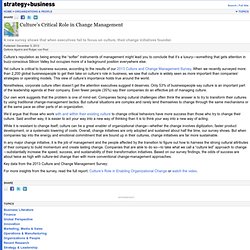
Culture’s reputation as being among the “softer” instruments of management might lead you to conclude that it’s a luxury—something that gets attention in buzz-conscious Silicon Valley but occupies more of a background position everywhere else. Yet culture is critical to business success, according to the results of our 2013 Culture and Change Management Survey. When we recently surveyed more than 2,200 global businesspeople to get their take on culture’s role in business, we saw that culture is widely seen as more important than companies’ strategies or operating models. This view of culture’s importance holds true around the world.
Nonetheless, corporate culture often doesn’t get the attention executives suggest it deserves. Engaging employees. Guest articles > Employee Communication: 6 Steps to Communicate Change by: Marcia Xenitelis Whenever we begin to design an employee communication strategy that is focussed on change the most important thing to consider is that the strategies implemented must engage employees, not simply inform.

In other words will the employee communication strategy you are implementing cause a change in attitude and therefore behaviour or is it simply information? When I talk about employee engagement in this context I am focussed on communication strategies that require the involvement of employees, that as a result the business issue means something to employees personally, they now understand the reason why for change and employees feel part of the process.